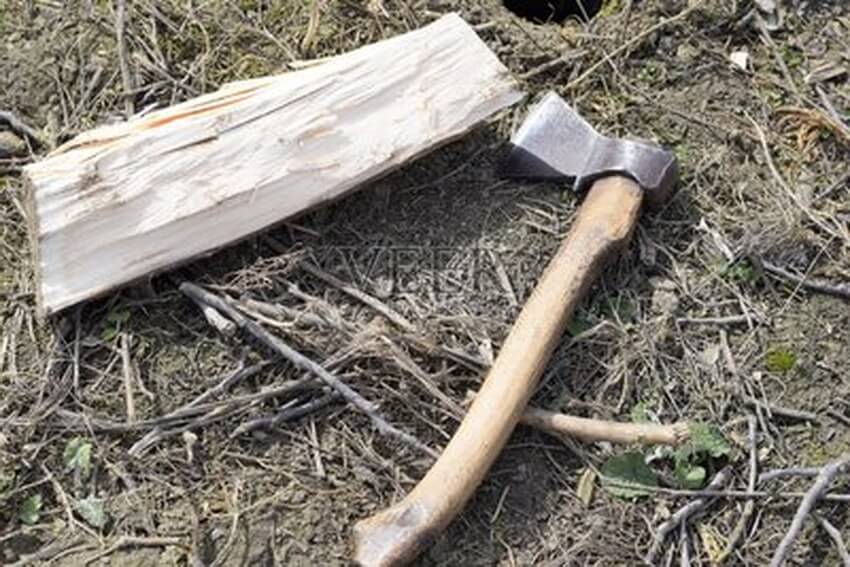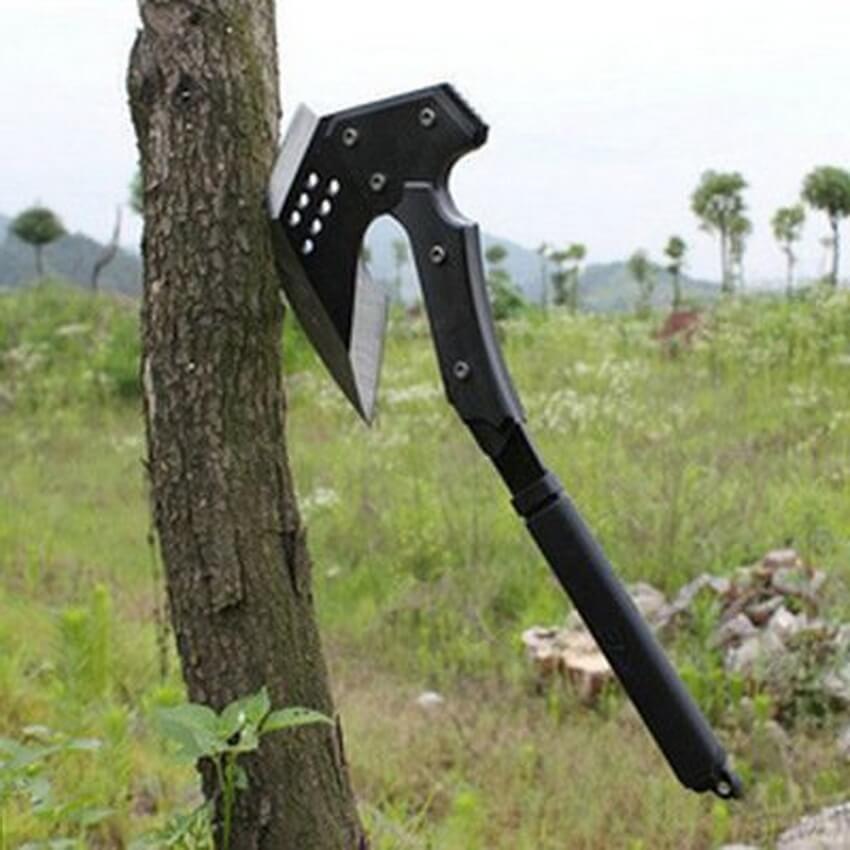![]() Windy
Windy
 WeChat
WeChat
 WhatsApp
WhatsApp
Click:287 seen
The proper use of the axe in the expedition can not only improve efficiency, but also ensure their own safety. Here are some key tips:
1. Prepare
Choose the right axe: Choose according to the type of expedition and purpose. Camping, hiking and other activities, choose a small single-handed axe weighing 2-3 pounds (about
0.9-1.4 kg), easy to carry and operate; If you need to cut a lot of wood, a 3 - to 4-pound (about 1.4-1.8 kg) two-handed axe is more suitable.
Check the condition of the axe: Before setting out, make sure that the axe blade is sharp, the blunt edge not only increases the difficulty of use, but also may slip when swinging and
cause danger. At the same time, check whether the connection between the axe handle and the axe is firm, whether there is loose or crack, if there is a problem, it should be repaired or
replaced in time.
2. Grip and stance
Correct grip: When using a one-handed axe, the hand should grip the back end of the axe handle to increase the power and control of the swing. The two hands of the axe are separated,
one hand in front of the axe, one hand behind, to maintain balance and power transmission. When holding the handle, the strength is moderate, which ensures that the axe does not slip
and can flexibly adjust the direction of the swing.
Steady stance: Feet shoulder-width apart, front foot slightly forward, back foot firmly supported, slightly forward, weight on the front foot. This stance provides a stable base of force to
avoid losing balance and falling while swinging the axe.
3. Swing tricks
Use body strength: Swinging an axe should not rely on arm strength alone, but with the help of waist twisting and leg push off, the force is transferred to the axe through the transfer of
body weight. For example, when cutting wood, first twist the waist to drive the back swing of the arm, and then swing the axe forward with the strength of the leg to achieve efficient cutting.
Control the swing rhythm: Maintain a steady, rhythmic swing and avoid rapid, irregular movements. Too fast rhythm is easy to fatigue and accuracy is reduced, and too slow rhythm can
not effectively exert the impact of the axe. You can practice to find your own swing rhythm.
4. Target selection and striking position
Choose the right target: When cutting down trees, choose the right diameter and no obvious decay or knots. Large diameter trees are difficult to cut down, and rotten or knotted areas are
easy to make the axe stuck or rebound. Generally, it is more appropriate to choose trees with a diameter of 10-20 cm.
Precise impact location: When cutting the tree, cut a wedge incision on the bottom side of the trunk, the depth of the trunk diameter 1/4 to 1/3, and then cut from the other side of the
relative position, so that the tree falls in a predetermined direction. When chopping wood, put the wood on a stable plane and hit the center of the wood grain to make it easier to split.
5. Safe use
Pay attention to the surrounding environment: before swinging the axe, ensure that no one is around, and there are no obstacles and people within a radius of at least 2-3 meters, to avoidthe axe disconnecting or bouncing to cause injury.
Properly place the axe: When not in use for the time being, put the axe blade down, insert it into a soft place on the ground, or put it in a special axe cover, and place it in a safe position to
prevent others from accidentally touching it.

Proper maintenance of the axe can extend its service life and ensure that it always maintains good performance during activities such as expeditions. Axe maintenance can be started
from the following aspects:
1. Clean
Clean up stains promptly: After use, the axe surface may remain wood chips, SAP, blood stains (if used to handle prey). Wipe with a clean, damp cloth as soon as possible to remove
surface dirt. If the stain is stubborn, you can add a small amount of neutral detergent in warm water, gently scrub with a soft brush, and then rinse with clean water. For example, if the axe
is contaminated with a strong adhesive SAP, you can cover the stain with a damp cloth with a cleaning solution and then wipe it.
Remove rust: If the axe is exposed to moisture for a long time, it is easy to rust. Once rust is found, use a wire brush or sandpaper to gently polish the rusty area to remove the rust layer.
After that, wipe off the rust with a clean cloth and apply appropriate amount of anti-rust oil. If the rust is serious, the axe can be soaked in a special rust remover for a period of time, and
then cleaned and anti-rust treatment.
2. Maintenance of cutting edge
Stay sharp: A sharp axe edge increases productivity and is safer. Regular sharpening of the axe edge with a whetstone is the key to keeping it sharp. When grinding, the whetstone is
fixed on a smooth surface, apply an appropriate amount of lubricating oil on the whetstone, so that the axe edge and the whetstone maintain a certain Angle (generally about 20-30
degrees), and then polish in the same direction, the intensity should be uniform, both sides alternate grinding, until the axe edge becomes sharp again. An electric knife sharpener can
also be used, but attention should be paid to controlling the grinding time and strength to avoid excessive grinding damage to the axe blade.
Prevent rolling edge and breakage: Avoid hitting hard objects with an axe, such as stones, metals, etc., so as not to cause rolling edge or breakage of the axe edge. If the rolling edge
appears accidentally, you can use the oil stone to fine polish and repair the rolling edge; If the breakage is more serious, it may need to be repaired with professional tools and techniques,
or take the axe to a professional tool repair shop for treatment.
3. Handle maintenance
Check for fastness: Before and after each use, check whether the connection between the axe handle and the axe is firm. If it is found to be loose, it can be solved by wedging the wedge
on the handle of the axe or using glue to strengthen it. For axes fixed with metal hoops, check whether the metal hoops are loose, and tighten them in time if they are loose.
Maintenance material: If the axe handle is wood, it is necessary to apply wood wax oil or linseed oil regularly to maintain the toughness of the wood and prevent dry cracking. To apply,
apply the oil evenly to the surface of the axe handle, and then wipe with a clean cloth to remove excess oil and leave to dry. If the axe handle is a synthetic material, such as glass fiber
reinforced nylon, etc., to avoid scratching with sharp objects to prevent surface wear.
4. Store
Dry storage: The axe should be stored in a dry and ventilated place, avoid wet environment. The axe can be hung on a hook on the wall to keep the axe edge away from the ground and
other objects to prevent collision damage. If conditions permit, desiccant can be placed in the storage place to further reduce humidity.
Protect the axe edge: In order to prevent accidental damage to the axe edge during storage, a special axe cover can be used to cover the axe edge. Axe covers are generally made of
materials such as leather or thick canvas, which can effectively protect the axe edge and prevent others from accidentally touching the sharp axe edge.

